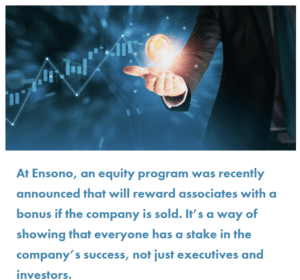Today’s biggest recruiting advantage is showing an investment in employee growth that goes beyond compensation.
By Meredith Graham
When rushing to fill roles in a tight job market with high turnover, it can be easy for recruiters to lose the plot in their hiring narrative.
Yes, The Great Resignation left gaps in teams that need to be filled and yes, it’s still a candidate’s market. But if there’s anything companies have learned, it’s that recruiters need to get creative–and it starts with telling a better story during the hiring process. What kind of growth does the company offer beyond the salary scale? Is the company’s success shared with employees? Are there opportunities for employees to have a greater impact both inside and outside the organization?
Answering these questions can help candidates see a future with a company, putting new hires more at ease and helping to reduce high turnover. Losing an employee can cost close to an employee’s entire annual salary and even higher for tech workers. Hiring employees who can see a long-term future with the organization from the start can help improve retention.
While every company has a unique story to tell, there are many common narrative elements recruiters can leverage to get talent to sign on and stick around. A company’s ability to attract and retain the right candidate will come down to more than just salary–organizations must tell a compelling story about growth. Even as signs of slowing appear within tech hiring, helping candidates see their paths forward is an evergreen strategy to retain talent. So how can organizations get candidates to see opportunities as early on as the first interview? Use these tips to help prospective employees understand long-term development and growth opportunities at the organization.
Show how your success is their success. The Great Resignation is a clear signal that employees are seeking more from their jobs and employers. While compensation is a big influencer, a more general reshuffling and reconsidering of priorities has also occurred. Candidates want to know how their hard work can help the company succeed and how they will be rewarded if it does.
Business leaders can make this connection by exploring more innovative ways to give employees equity. For instance, at Ensono, an equity program was recently announced that will reward associates with a bonus if the company is sold. It’s a way of showing that everyone has a stake in the company’s success, not just executives and investors. It’s not a traditional benefit, but it’s a perk that shows current employees exactly how their hard work can pay off and helps attract more candidates into the hiring pipeline.
Highlight the impact employees can make. Conversations with candidates shouldn’t stop at how they will fit into a role. Recruiters should also make sure they’re aware of all company initiatives, working groups, and resources that candidates might be interested in. Does the organization have a strong support group for women returning from maternity leave? What about a community of developers that do pro bono work? These are the kind of opportunities candidates look for–a way to make an impact and do some good while still doing work.
Offer an agile career path. Candidates are often interviewing for a single open position, but it doesn’t mean they shouldn’t understand what career possibilities lie ahead. Recruiting materials and conversations should be as comprehensive and clear as possible about the type of advancement opportunities that are offered. Whether industry events, training seminars, professional certifications, tuition reimbursement–it’s critical that companies ensure they are telling a cohesive and complete story about career growth and professional development. Studies show that employees at companies that have internal mobility stay twice as long, so investing in this kind of infrastructure for career growth is worth it in the long run.
At Ensono, one of the company’s academies that focuses on aging mainframe technology, has attracted a diverse group of individuals and has become one of the most popular growth programs. Military veterans, moms returning to the workplace, tech industry veterans, and mid-career pivotors have all engaged and built a community. There’s also no concern about employees taking these new skills and certifications elsewhere. When associates feel that they are being invested in, strong trust is built that is difficult to break.
The way businesses recruit and retain talent has evolved–and the story companies tell has to change, too. By adjusting narratives, organizations can turn candidates into new hires with a long-term vision of their future.
Meredith Graham is chief people officer of Ensono















